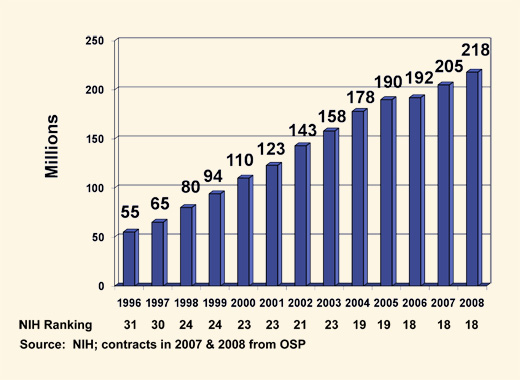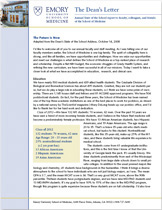Research
We have developed enormous depth in our research enterprise that allows us to attract and retain outstanding scientists and to compete effectively for federal funding. One of our school’s statisticians told me that there are 101 faculty who bring in more than $750,000 a year in research awards. Within that 101 is a subset of 71 who bring in more than a million. To grasp the sea change in the ability of our faculty to compete for NIH grants, know this: Just 12 years ago, there was a total of eight faculty who brought in more than $750,000 a year.
We are ranked 18th in NIH funding with $223 million, the same position as last year. That’s an increase of 9% over the past year—remarkable given that the NIH budget has decreased. The SOM continues to grow at the second fastest rate of the top 20 medical schools, 12% over the past 12 years, in fact.
It is noteworthy that we continue to do well in garnering large grants. For example, Mark Mulligan in the vaccine and treatment evaluation unit; Rafi Ahmed for an immune inhibitor protein grant; Chris Hillyer for a blood transfusion grant; molecular translation in the imaging center with Carolyn Meltzer and Mark Goodman in radiology; and Paul Doetsch with oxidative stress and colon cancer.

Researchers won’t get large grants if their medical school doesn’t have highly ranked departments. Eight of our clinical departments are in the top 20, and six are in the top 10. Five of our basic science departments are rated in the top 20, and two are in the top 10. Again, we have seen this increase year after year, a testimony to the quality of the faculty.
As many of our researchers know, we have a shortage of space. We have more people doing more research in less space than ever before. As a result, we have increased the efficiency of our space utilization. We also have rejuvenated the space committee under Executive Associate Dean for Research Ray Dingledine. In the new Rollins School of Public Health building, which is set to open in 2010, we will occupy one floor, about 20,000 sq. ft. In addition, we are planning to construct a building with up to 200,000 sq. ft. of space on the Turman site, and then at our midtown location we will have up to 100,000 sq. ft. of new space.
These new buildings will provide enhanced space for our existing departments and centers and enable them to expand their research and broaden collaboration. Translational and clinical research efforts will be furthered by the hospital and clinic space. Both are being designed with knowledge that research and education are key differentiators for Emory Healthcare and that it will make the clinical enterprise even more successful.

